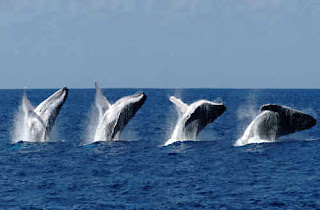
One of their mysterious characteristics, still being studied, it is their voice and their language, the immense mass of liquid that contains them.
This song accompanies the journey of the whales in the oceans and is present in all the most significant moments of their lives, such as those related to reproduction of the species, courtship, mating, birth of children and their integration in the life of the pack.
Scientific studies have found that among the humpback whales only emit those sounds, and of them only boys. They "sing" differently depending on the group of whales which they belong, and each group are different "songs" in the case of contacts between why different groups undergo changes, variations and changes, as an exchange of music.
The whale song was recorded and analyzed not only by scientists but also by the musicians. The result was a striking juxtaposition between these sounds and some specific musical frequencies, especially in those songs before mating and those that guide the puppies orientation, as if they were of "serenity" or "driving reasons for the small newborn.
The biological process used to produce sounds ranging from a family of cetaceans to another. While it is considered that the complex and deep sounds of the humpback whale (and a few blue whales) are primarily used for courtship (see next section), sounds simpler than other whales are used throughout the year. While the toothed whales (including killer whale) are able to use echolocation (mainly the emission of ultrasound) to detect the size and nature of objects with great precision.
Source: Author: Marina Pinto Scienzaonline "
Whales and poachers
Despite the strong international consensus that has for decades opposed to commercial whaling - Japan, Norway and Iceland, ignoring the global ban in this matter, continued whaling by exploiting a window of opportunity that allows them to submit their shipments as "scientific research".
 Forty years ago, whales were on the brink of extinction. But thanks to global social movements, the world established in 1986 the ban on commercial whaling. This ban was one of the greatest victories of the environmental movement. Japan, like Iceland and Russia, is among the few states in the world where commercial whaling is permitted, especially for food. The reason why Japan can bypass the nation a common law at the global level is discussed (and controversial) exemption, for reasons related to scientific research. But the reality exposed by the team of researchers and conservationists is that whale meat comes not only on the tables of restaurants in Tokyo, violating regulations which prohibit international trade.
Forty years ago, whales were on the brink of extinction. But thanks to global social movements, the world established in 1986 the ban on commercial whaling. This ban was one of the greatest victories of the environmental movement. Japan, like Iceland and Russia, is among the few states in the world where commercial whaling is permitted, especially for food. The reason why Japan can bypass the nation a common law at the global level is discussed (and controversial) exemption, for reasons related to scientific research. But the reality exposed by the team of researchers and conservationists is that whale meat comes not only on the tables of restaurants in Tokyo, violating regulations which prohibit international trade. not served the indignation and condemnation of environmental groups like Greenpeace and WWF (participating in the Commission's Scientific Committee as an 'observer') to deter the Land of the Rising Sun by intensified hunting, instead of adding two new species (the humpback whale, endangered, and
a particular type of whale) to the four already hunted (the sperm whale, fin and the rostrata).  |
| A whale and her baby, probably still suckling, freshly caught are hoisted on the deck of a ship. |
Audrey Cardwell, a Greenpeace activist, said the pay would be just looking at them, 60 thousand 'whale watchers' have led to Reykjavik profits for more than 14 million dollars. The 'whale' in Australia has exceeded its half million in 2004, bringing the national economy the equivalent of 180 million euro, in a sector that continues to grow at a
rate of 15% per year.






0 comments:
Post a Comment